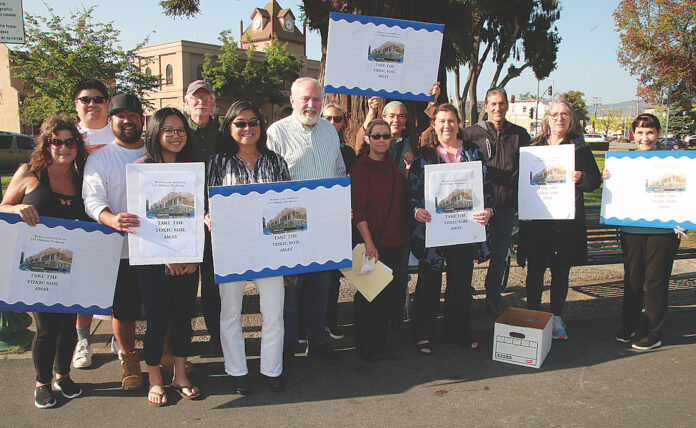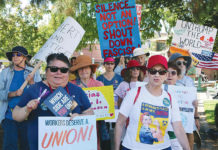
WATSONVILLE—A group is planning to file a complaint to the California Attorney General’s Office against the city of Watsonville and the County of Santa Cruz for advancing a housing project that they say will create an environmental hazard for its future residents and a massive liability for the city.
The Watsonville Committee Against Toxics plans to file the documents with Rob Bonta’s office in the coming days. Their complaint, according to committee member Lisa DuPont, will claim that the jurisdictions’ approval of plans for Hillcrest Estates—a long-delayed, 144-unit housing development off Ohlone Parkway—is out of compliance with several mandates of the Environmental Justice in Local Land Use Planning Act, and is putting the future residents’ health at risk by allowing the developer to bury roughly 20,000 cubic yards of contaminated soil in a cement-capped pit on the 13-acre property.
A 2021 report from a consultant contracted by developer California Sunshine Development LLC found that the top two feet of soil on the site of the former vehicle junkyard contained varying amounts of lead, arsenic, cadmium and other fuel-based contaminants. Some of these toxins were found at levels that greatly exceeded various environmental and government standards.
Watsonville City Council approved a development agreement for the project at its Tuesday night meeting that will allow Sunshine Development to move forward with the project in five phases, so long as it can gain final approval from the county’s Department of Environmental Health.
The agreement will allow the developer to sell off the homes—29 of which will be reserved for low- and moderate-income residents—in waves as it completes the project over four years. However, it will also pass on the responsibility of maintaining the pit to the homeowners through the forthcoming homeowners association, a move that critics say could saddle the future residents with a seven-figure bill if the pit ever fails and the contaminants spread into the nearby slough or sicken residents.
Councilmembers Jimmy Dutra and Rebecca Garcia voted against the development agreement.
A rejection from the council on Tuesday would not have halted the project, which has been a thorn in the side of the elected leaders since it first surfaced in 2018. It would have only meant the homes could not have been sold in waves over the course of the construction.
Over the past five years, the development has faced heavy pushback from neighbors concerned about increased traffic, had troubles with securing funding and changed names (it was previously Sunshine Vista) and project managers, multiple times.
It first received approval in 2018, and council gave the developers a two-year extension in 2020.
The development team returned to the council last year to propose a major change to the soil remediation plan. Instead of excavating, hauling and disposing of the top 2-foot layer of soil, the developer proposed removing only the top six inches and burying the remaining 18 inches in the cement-sealed pit.
The council approved that plan in a 4-3 vote.
The developer has maintained that without this concession the project would not be financially viable, that the plan meets all of the county and state health requirements, that soil capping is an EPA-recognized action to remediate properties and that no homes or fields will be built over the pit—a road and a basketball court will be built on top of it, according to the site plan.
But various environmental groups and neighbors say that the city has approved the creation of a de facto toxic waste dump, and that the pit—and its retaining walls separating the contaminated soil from the slough and homes—is bound to fail in a catastrophic earthquake.
About a dozen people spoke to the council about the issue on Tuesday, and all of them opposed the project. Some, like DuPont, were speaking against the development for the first time. For others, the meeting was the latest chapter in a long-running battle.
Like many residents in the Sea View Ranch neighborhood, Noriko Ragsac has spoken against the development multiple times over the past five years, first raising concerns about additional traffic and loss of green space if the project would be approved. But Ragsac and other Sea View Ranch neighbors maintain that their issue is not with housing being constructed.
“We do want housing,” Ragsac said after the meeting. “We want that project to be built, but safely.”
The majority of the council said that they trust the county’s judgment on the remediation plan, that Watsonville was in dire need of new homes available for purchase and that this was the latest ploy from nearby neighbors to stop the development.
“They don’t want people to move in,” said Councilman Eduardo Montesino, who oversees the area of the city where the development is taking place. “Even if we get the perfect conditions, they’ll still find other avenues to say ‘no.’”
Councilman Francisco “Paco” Estrada echoed Montesino and said that Watsonville was a town of “haves and have nots,” highlighting the rift between homeowners and those struggling to buy a house under current skyrocketing home prices—many of the latter being people of color. He also asked those in attendance to visit the California Department of Toxic Substances Control’s website and view the agency’s map of sites that have undergone remediation. That list of local properties includes the Tannery Arts Center in Santa Cruz, which was once a leather tannery.
“Building housing here is already tough enough and this false dichotomy that we have to pick between safety and housing, is ridiculous,” he said. “The year is 2022. I think technology has gone far enough where we can do both, where we can do housing and we can do it in a safe way where it will not affect people’s health.”
Councilwoman Vanessa Quiroz-Carter, who was not on the council when it approved the new soil plan last year, said that because of restrictions on outward growth as a result of an “urban limit line” approved by Watsonville voters in 2002—the same limits a group is trying to extend through 2040 in the November election—that the council must move forward with infill housing projects when they come before them.
“If we are asked to have housing, and we are asked to build within our housing limits and this is what is available, then I’m going to say we have to build with what’s available within our lines,” she said.











